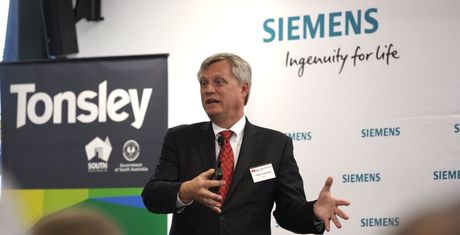Siemens ups the ante on submarine building and the innovation agenda

Visiting global president and CEO of Siemens PLM Software, Chuck Grindstaff, whose technology is behind projects such as the Mars Curiosity Rover through to the US Navy USS Gerald R. Ford aircraft carrier, has flagged a multimillion-dollar software in-kind grant should Germany be selected to build Australia’s next fleet of submarines.
At an event held in Tonsley, Adelaide’s innovation hub, Grindstaff highlighted how the establishment of a Digital Shipyard in Adelaide could help the state transform into a hub for high-tech manufacturing, innovative ideas and increased employment. Drawing on his experience with the manufacturing renaissance in the US and the approach to naval shipbuilding in the state of Virginia, he said the Australian economy could benefit greatly.
“The manufacturing industry in America is on the rise and is being transformed by a software revolution that is enhancing productivity, increasing efficiency and speeding time to market,” said Grindstaff. “Australia is faced with a unique opportunity through its defence investments to help local industry rapidly transform and prepare to participate in advanced manufacturing and Industry 4.0.”
In Virginia where shipbuilding is core to the state’s economy, Siemens provided $1 billion of in-kind software to equip students with the Digital Enterprise Software Suite that will help them build the world’s most complex ships for the US Navy.
“Should Germany be selected to build Australia’s next fleet of submarines, I could see a multimillion-dollar in-kind Siemens PLM software grant to help re-tool Australia’s next generation of workers,” said Grindstaff. “It’s no longer about who has the strongest back, but who best uses their brain and receives the best training in areas like mechanics, mechatronics, computers, software, design and engineering.
“Digitalisation of industries weaves digital threads through the entire value creation chain. We are witnessing this in the US state of Virginia where, through a $1 billion Siemens grant and the establishment of a Shipbuilding Centre of Excellence (CoE), the state is focusing on equipping students with tools and training that will help them build the world’s most complex ships. This digitalisation is upskilling students, academia and the workforce in advanced manufacturing technologies used not only in shipbuilding, but also aerospace, automotive, machinery and other industries.
“A combination of Germany’s Industry 4.0 vision, the access to advanced manufacturing technologies already in application in the US Navy and Australia’s Innovation Agenda will help retool Adelaide and Australia for the digital age of manufacturing,” said Grindstaff. “Put simply, I could see a rebirth of shipbuilding in Australia with flow-on effects to all industry and the potential to seed Australia’s manufacturing Renaissance — similar to what we’re seeing in Virginia.”
The comments from Grindstaff, who is based in the US, support German company thyssenkrupp Marine Systems’ recent commitment of building a Shipbuilding Centre of Excellence (SCOE) in Adelaide. According to thyssenkrupp Marine Systems Australia Chairman John White, such an approach would greatly reduce risk for the Royal Australian Navy.
“The Shipbuilding Centre of Excellence in Australia would benefit all defence programs and ensure common software platforms to strengthen Australia’s approach. It would help connect the Royal Australian Navy to academic institutions and industry so we embed a continuous and sustainable high-tech shipbuilding industry. SEA 1000 has the scale to change the way ships are built in Australia; it provides a generational chance to advance the manufacturing industry.
“An advanced (digital) integrated product development and support environment (IPDSE) would avoid the pitfalls of the past where data has been difficult to manage and major programs have often relied on 2D paper diagrams. With modern technology everything can be designed and tested collaboratively in a digital world before going anywhere near a prototype,” said White.
Also commenting on thyssenkrupp Marine Systems’ SCOE, Jeff Connolly, CEO of Siemens Australia and New Zealand, said, “Australia has a one-time unique opportunity to ignite its economic growth engines by leveraging the investment in submarines and frigates for the benefit of the whole of industry.
“We recently made an in-kind grant of $2.7m of software with the SA government and Simulation Australia. Whilst this underlines that we are in the country for the country, what is critically important is that by using the right tools Australian industry becomes more globally competitive,” said Connolly. “If Australia were to leverage the future submarines and frigates investment for the whole of industry, then the economic benefits could be vast with rapid transfer and adoption of key skills and tools. With the right skills and tools, Australia can combine its renowned ingenuity to kickstart the ideas boom of the 21st century.”
Siemens showcases AI that autonomously executes engineering tasks
Siemens demonstrated generative AI-powered Copilots executing autonomous workflows at the SPS...
Claroty releases AI-powered device library technology
Claroty has released an AI-powered OT device library to improve asset visibility and...
Webinar: Turning data protection into a business advantage
Backup is no longer a safety net, but a strategic tool for risk reduction — and the...







